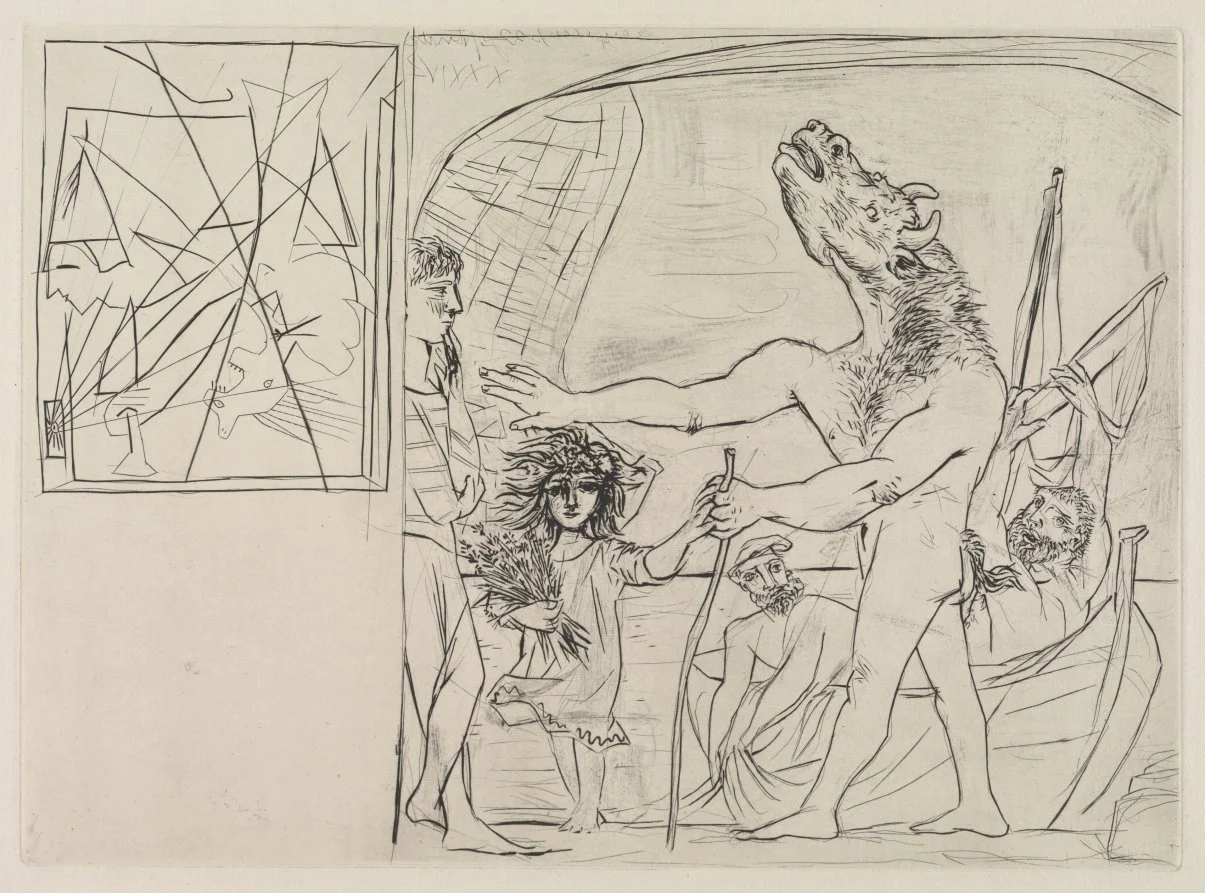The Minotaur
At the mouth of the labyrinth Ariadne runs up to Theseus and embraces him. The affection is genuine. Past experience foretells that Theseus will not return from the depths of the labyrinth and from his direct experience of the monster roaming its convoluted passages. But Ariadne is motivated by more than a simple and sincere sadness for the fate of the young man. As she embraces Theseus she slips a length of the most finely woven thread into his hand. She whispers the plan to Theseus. She will stand by the opening with the thread in her hand while he navigates the corridors. Should he encounter and defeat the Minotaur she tells him that all he need do is follow the thread back to the opening and to her. The interior darkness and the complexity of the situation need not be an impediment to his safe return to the realm of light and to her embrace.
Theseus is moved by her optimism and by the boldness of her defiance of her father in rendering him assistance. He is an innocent victim of the retribution demanded by King Minos of Athens for the death of his son, Ariadne's brother. He knows the likelihood of his return to be small. And he makes her promise that she will not enter the darkness after him should he not follow the thread back out after some period of time.
Ariadne promises. Theseus enters the absolute darkness of the labyrinth.
Hyper-sensitivity and attentiveness characterize Ariadne. The thread serves not only as a guide back to the entrance. Ariadne's disposition allows her to access the communicative significance of the vibration passed along the length taut thread. The thread communicates in vague tugs the mental and physical state of Theseus in the unlit conundrum of the maze. And she realizes that she is able to communicate with him as well. The thread mediates communication between the world of inside and the world of outside.
Time passes. Theseus advances. Ariadne waits.
The thread rages. Ariadne has no doubt that Theseus has encountered the Minotaur in the blackness. Fear grips her. She cannot breath. The line vibrates terrible secrets of brutal violence. And as quickly as the rage errupted it stops. The thread no longer speaks.
Time passes. Ariadne waits. The thread remains mute.
Day becomes Night. Night advances toward day.
After some immeasurable amount of time the thread quivers again. Theseus tells Ariadne from the deep abyss that he still lives.
My aim in outlining this mythological narrative has been to create a paradigm for understanding the artistic process.
"In the following, we shall weave the fiction that we are able to split our adventurous intelligence in such a way that one half of it takes up position at the entry ramp to the mystical cave--still viewing it from the outside, that is--while the other half is initiated to enter the homogeneous totality of darkness. The two halves should remain in contact during the excursion--the one inside by reporting its states in the objectless sphere to the outside, and the one waiting 'ante portas' by sending suggestions for the verbalization of the indescribable into the cave." (Peter Sloterdijk, "Bubbles," pp. 284-5)
This is the state of creativity. The seeking intelligence immersed in the infinite blackness of seeking assisted by suggestions of the observing intelligence... creative histories and paradigms, technical possibilities, conceptual frameworks... communicated by the observing to the immersed seeker in order to give voice to the experience in hopes of replacing the usual course of events when deep and fundamental search creates a "mystical muteness" because the depth and intimacy of the experience has turned "speaking theory" into "silent theory." (Sloterdijk, "Bubbles," p. 285).
The artist is both seeker and observer. A whole intelligence with two whole hemispheres. The resulting work a mediated product of that intimacy between the two hemispheres. Ariadne and Theseus. The monster--the Minotaur-- is a monster not by nature. It is monstrous by the immensity and complexity of its insurmountable vagueness. The Minotaur is not a monster by nature. It is a monster because it has no nature. It is a non-object--or, as Thomas Macho calls such phenomenon, "nobjects." The Minotaur incites fear and even kills because it paralyzes the slightest effort to categorize, describe or comprehend. The Minotaur defies analysis. The creative seeker/observer can offer but tugs on a mediating thread to speak of his or her experience of the Beast of Infinite Vagueness and Non-Objectivity...the beast of direct and intimate experience at the deepest level of human structure. Its rage and fear immerse completely. Darkness and paralysis.
The artist is the trinity of Ariadne, Theseus and the Minotaur. The thread suggesting the character of this triune relationship is the work of art. The biosphere that contains all these elements is the creative act.
Image: Blind Minotaur (1934), Pablo Picasso

